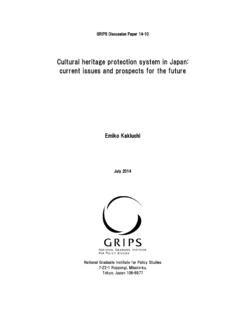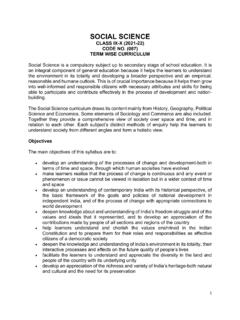Transcription of Taimyo Heritage: From Shakyamuni Buddha to Today
1 1 Taimyo heritage : From Shakyamuni Buddha to Today By Andrew Stones, adapted by Haruyoshi F. Ito Introduction The story of Taimyo begins in India with the historical Buddha , and moves through the Chinese Shaolin martial arts tradition, Okinawan karate and Shotokan karate to Shintaido in Japan. The thread connecting it all is expressing ki energy in Nature, building on the heart of what has come before and opening to creative inspiration that pulls tradition into the present. India: The Historical Buddha Ananda moved with energy and purpose through the forest. He was going to see his spiritual teacher, Shakya-Muni, the sage of the Shakya tribe, also known as Gautama Siddhartha, Buddha , and He Who Has Awakened. Shakyamuni took the spiritual community of Northern India by storm with his radical teaching of letting go: letting go of attachment, letting go of superstition and ritual. Simply to sit, no desire for anything. Just to be. This was the path he taught to release the human mind from suffering.
2 Somehow the presence of this man touched people and encouraged deep transformation. Just sitting in his presence brought groundedness and clarity. Ananda could feel that giant presence already, even a mile away. Thousands would be there to sit in the master's presence, to be with him, to listen to him as he turned the Wheel of Dharma. Ahead was a massive clearing, filled with people. The master s presence was palpable, a living energy in the air. You could almost hear it, see it, touch it. Ripples of energy flowed from the master's chest, and when he stood, the clearing was bathed in light. Some fainted, others gasped. But the Buddha smiled and reached out, palms down, as if to say "It's ok friends, this energy is our birthright. Be at peace; there is no need to fear." Buddha turned the Wheel of the Dharma for many years. He taught through words, through direct mental transmission, and through his body and his physical presence. He transmitted his enlightenment mind-to-mind, speech-to-speech, body-to-body.
3 In his physical embodiment, the Buddha s gestures became known as mudra or seals: each gesture sealed a teaching, an aspect of the enlightenment experience. The gesture with palms extended, facing forward and down became known as the seal-of-the-bestowal-of-fearlessness: "Zemmui-in." 2 China: Bodhidharma and Vajramukti Bodhidharma was angry. He had travelled all the way from India with the Buddha 's teachings to enlighten the Chinese, and they were falling asleep in his meditation sessions. At the Shaolin Temple where Bodhidharma lived and taught, meditation sessions were long and grueling. Bodhidharma ( Dat Mor in Chinese, Daruma in Japanese), was hard-core. A warrior by birth, he did not suffer fools or slackers. There was only one solution. He decided to teach his Chinese meditation students the Indian art of Vajramukti, the warrior caste martial art that he had learned as a boy. He hoped this would give them more energy, more fitness, and more perseverance for his meditation sessions.
4 He would integrate the Buddha 's teachings, specifically those contained in gestures mudra into the martial art. Each kata, each form, would be just as much a "Dharma dance" as a martial sequence. Bodhidharma s new form of the ancient Vajramukti was successful; his Chinese students gained remarkable energy, which profoundly improved their meditation and awareness. Each of his Vajramukti forms was three-in-one: simultaneously a fighting sequence, a keep-fit exercise, and a Dharma dance a physical representation of the teachings of the Buddha through gesture. As the centuries passed, the Buddhist Vajramukti tradition begun at the Shaolin Temple by Bodhidharma became known as Shaolinszu chuanfa Oap, Shorinji Kempo, the Fist-Dharma of the Shaolin Temple Shaolin Kung Fu. China: Shaolin Kung Fu Fang Qi Niang combed her hair and thought about life, sitting outdoors in the morning sun. A young woman alone, outdoors with no protection; one might have thought she would fear bandits and robbers.
5 But she was not afraid. Fang was a master of Shaolin Kung Fu, taught since early childhood by her father. It was many centuries since Bodhidharma had inspired monks of the Shaolin Temple into action by teaching them his own version of Indian Vajramukti. Shaolin Chuan had grown and developed into a multitude of styles, and indigenous Taoism had imbued the original Indian forms with Chinese consciousness. Like Japanese Shinto, Taoism reveres nature. Practitioners harmonized their consciousness with Great Nature in all its forms, shape-shifting their awareness through earth, water, wood, metal and air, becoming one with animals, plants and rocks. This harmonization promoted medical awareness, spiritual awareness, and even martial arts awareness. Adepts from the Shaolin Temple developed fighting styles aligned with animals: Praying Mantis, Tiger, Snake, Eagle, Horse, Dragon, Monkey, and many more. Through their Chinese evolution, Shaolin Kung Fu forms were now four-in-one: keep fit exercise, Dharma dance, fighting form, and ways of harmonizing with Nature.
6 Shaolin Kung Fu had become a truly Chinese shamanic martial art. 3 Fang was a formidable Shaolin shaman. As she combed her hair that morning, a large crane landed close by, fascinated by her mirror glinting in the morning sunlight. Suddenly, the crane swooped in to steal the mirror with its sharp beak. Any normal person might have been intimidated, but Fang s reactions were honed by years of training. The bird pecked for its prize, but she blocked and parried, whirled and twirled, and the bird flew off. The next day the same thing happened again. The crane arrived, tried to seize the mirror, and Fang fought it off. By the third day, Fang realized that the "fight" with the crane was more like a playful game, as if the bird wanted to show Feng its spirit and its spirited movement. Fang followed her shamanic Shaolin training; she harmonized with the bird, received its spirit, and White Crane Kung Fu was born. This Buddhist Shaolin style was replete with Dharma seals of the Buddha , and was also a truly Chinese style, imbued with the spirit of Nature and in this instance the spirit of the Crane.
7 White Crane Kung Fu soon became one of the most popular martial art styles in Southern China, and a myriad of forms (kata in Japanese) emerged from its variations. One of these was the form known as Lu Pi ( in Chinese, Rohai in Japanese) Vision of the Crane. Japan and Okinawa: Funakoshi Gichin Funakoshi, the first man to teach the Okinawan art of Karate in mainland Japan, sat in his small tatami room in Tokyo. He felt pleased. The newly enlarged syllabus of Shotokan kata was finished, after months of work by him and his son Yoshitaka. When he arrived on the mainland a few years earlier he had brought with him only fifteen kata from his native Okinawa. But his friend Kenwa Mabuni, another Okinawan master teaching on the mainland, knew over sixty! Funakoshi had asked his son to go and learn more kata from Mabuni so the Shotokan syllabus could be broadened and the affable Mabuni had obliged. One of the kata that Yoshitaka learned from Mabuni was Rohai. Like many Okinawan Karate kata, Rohai had its origins in a Chinese White Crane Kung Fu form.
8 Yoshitaka and Gichin worked on this kata together, modifying the three kata that Mabuni taught (Rohai shodan, nidan and sandan) and amalgamating them into just one kata for Shotokan purposes. Funakoshi decided to remove all the Tsuru Ashi Dachi (crane leg, or one-legged stances) that did not seem to align with Shotokan's orientation. He made sure to keep the very first moves accurate to the original as well as the rest of this graceful kata. These were truly Buddhist Shaolin moves: a deep gathering of ki with closed fists at the waist in horse-riding stance, followed by a careful and precise Morote Zemmui-in (double-handed fearlessness seal). Now the only question was what to call this kata? Funakoshi liked to rename all his kata when he incorporated them into Shotokan. Contemplating the Buddhist nature of the form its clarity and simplicity he recalled the story of the sixth Zen patriarch s selection in China (Bodhidharma was the first patriarch). 4 "What is Zen?" the fifth patriarch asked the candidates.
9 "Zen is the wiping of dust from a mirror!" answered the first candidate. To this, the second candidate simply responded, "No dust; no mirror." Funakoshi smiled and said, "Yoshitaka, I ll call this kata Bright Mirror, Meikyo!" Japan: Egami There is a deep sense of joy, exhilaration, and freedom in a true creative flow. As Shigeru Egami looked out at the horizon, he felt this joyful exhilaration in every cell of his body. Ever since his friend Okuyama returned from a mountain retreat, things had been opening up for Egami. A veteran karate practitioner with over twenty years of experience, Egami thought he had nothing left to learn about karate. But the young Okuyama shared new principles from his time deep in the mountains, and those principles had opened Egami's mind to new possibilities. Relaxation and flow. Egami had always known that you have to be relaxed to move fluidly in karate. But Okuyama s depth of relaxation and wholeness of flow were entirely new. The whole thing was just so.
10 Revolutionary! And this inspired Egami, not only to experiment with Okuyama s new ideas, but also to be equally revolutionary himself. Now the flood gates of creativity were truly open, and the ideas flowed thick and fast. How can karate truly flow, truly gather and reflect the ki of Nature? How can Great Nature's Spirit truly infuse our karate practice, and how can we use movements that are shaped to truly reflect and enhance this infusion? That morning he was contemplating the first two movements of Meikyo Kata; the deep gathering of ki at the koshi with closed fists, followed by that beautiful expression called, in karate, Morote Shuto Uchi, or in Buddhist terms, Morote Zemmui-in. How could we make these movements even more powerful, even mor e reflective of Nature's grace? And even more transformative for our hearts and minds? And then he knew: first, rather than taking the fists straight to the waist, extend the open hands forward, as if literally gathering ki from the far distant horizon; then the condensing becomes even more powerful and profound.









